It takes some practice and knowledge to grow carrots the right way but once you figure it out carrots are maybe the most rewarding and fun crop to grow in the home garden. This complete guide to growing carrots will teach you everything that you need to know.
Oh carrots! They can win just about anyone into this home garden business and homesteading lifestyle. There is simply nothing like pulling a fresh carrot from your own garden.
I have to say that you’ve never really tasted a true carrot until you have tasted an organically grown carrot from your garden or someone else’s. They are sweet and so full of flavor! Nothing like the ones we find at the store.
The Complete Guide to Growing Carrots…
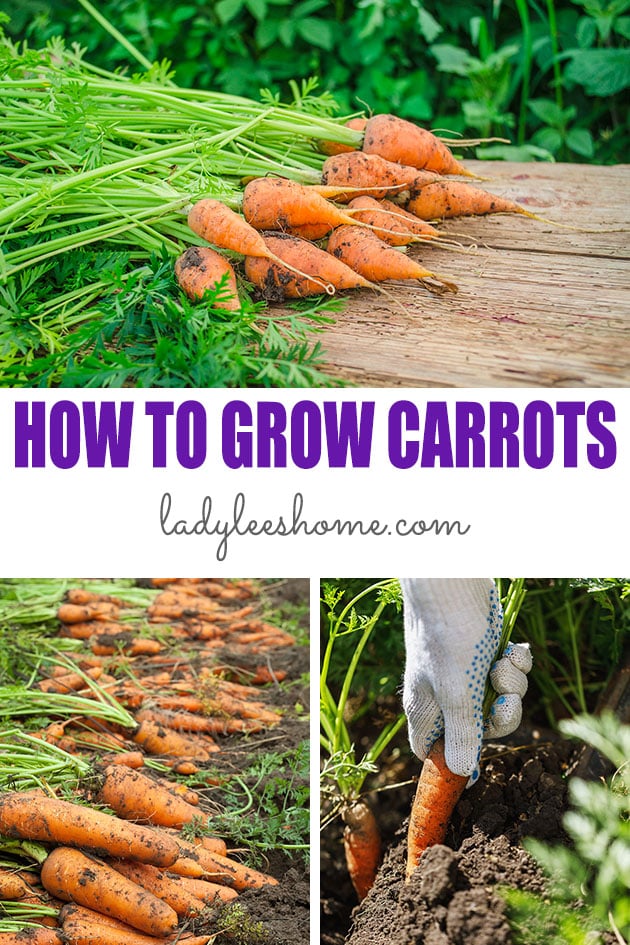
But carrots are not the easiest crop to grow. You need to learn which variety does best where you live, how to plant them and make sure that they germinate, and how to care for them.
In this complete guide to growing carrots I want to share with you everything that I’ve learned over the years so you can grow this amazing crop yourself and be successful every time!
Table of Content…
- Best Varieties of Carrots to Grow.
- When to Plants Carrots.
- Soil Requirements For Growing Carrots.
- How to Plant Carrots.
- How to Thin Carrots.
- How to Care For Carrot Plants.
- How to Harvest Carrots.
- How to Store Fresh Garden Carrots.
- How to Use Carrots Tops.
Best Varieties of Carrots to Grow…
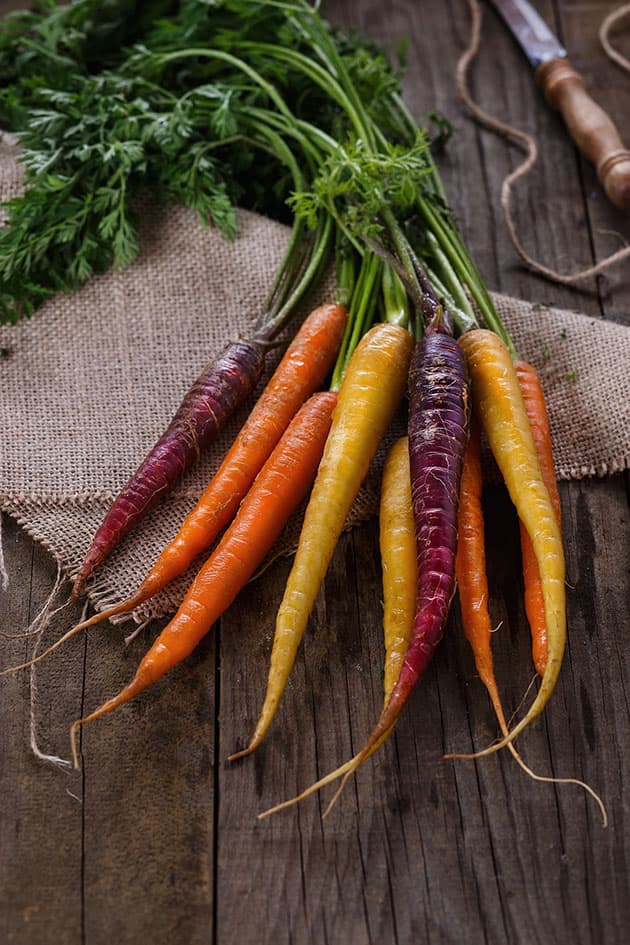
The carrots that we find in the store are long and orange, however, carrots come in many shapes and colors. Carrot varieties are divided into categories based on their shape. Some of the main categories are…
- Danvers – long and skinny with long tops.
- Nantes – almost perfectly cylindrical with scattered tops. Very sweet.
- Chantenay – short and chubby with long tops. Store very well.
- Mini – grow to 3-4” and often shaped more like radishes.
- Imperator – the kind that we usually see in the store. Long carrots with fast-growing foliage.
A little more info to help you choose….
Colorful carrots – aside from the orange carrots, you can find seeds for yellow varieties, purple varieties with orange center, purple varieties with a purple center, and reddish varieties. Keep in mind that if you’d like, you can buy a few varieties of different colors, mix the seeds, and grow them together in the same bed since cultivation is the same for all carrots (even if they are from different type groups).
Different shapes of carrots – the most common carrots are long, anywhere between 6” to 10”. However, you can also find short, round carrot varieties like these Atlas carrots. Even though every variety of carrot can be harvested at its baby stage (more on this later), you can also find true baby varieties that stay small at 3-4” like these Adelaide carrots. There are chubby carrots and also long and thin carrots.
Take into consideration that chubby or short and round varieties might need a little bit more space to grow (between each carrot in the bed). On the contrary, baby varieties or thin varieties might need less space between them. But other than that, growing these varieties is the same as growing all other carrots.
Storage carrots – if you have a root cellar or another sort of cold storage room, carrots are a great storage crop to grow. They store well in the ground through the winter (more on this later), however, if you live in a very cold climate leaving them in the garden might not be an option for you. A good storage variety to look into is Bolero.
Recommended carrot varieties – of course, there is no arguing about taste. You should try different kinds and see which you like best. However, my experience is that the Nantes carrots taste the sweetest. Varieties that I like are Napoli, Yaya, Purple Haze, and Nelson. My favorite place to order seeds from is Johnny’s Selected Seeds. You can view their carrot seed selection here.
When to Plants Carrots…
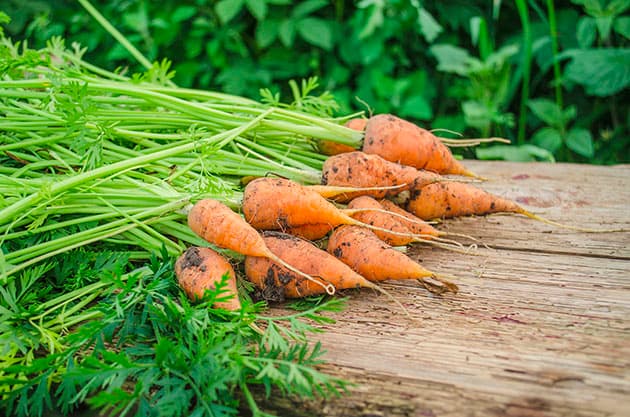
Carrots are a cold-weather crop. The seeds won’t germinate in hot soil and if you leave mature carrots in the garden when the weather is very hot they will become woody and tasteless. Ideally, plant carrots when soil temperature is around 40 degrees F and air temperature is around 60-65 degrees during the day.
In very warm gardening zones (deep South states like Arizona and Florida), you’ll probably plant carrots in the fall and grow them through the winter. In the Southern states (like NC, VA, and so on) we can plant carrots as early as February. We’ll stop planting in late April and then plant again in the Fall for a winter crop. In Northern states with a colder climate, you’ll probably be able to plant carrots all through the summer.
Soil Requirements For Growing Carrots…
Carrots love very loose and well-drained soil that is NOT too rich in Nitrogen. To grow straight and long carrots make sure that you loosen the top 10” of your soil with a broadfork (there is no need for tilling) or grow carrots in raised beds.
Don’t over-fertilize the carrot bed! Carrots don’t like soil that is too rich in Nitrogen so be careful with adding too much animal manure or Nitrogen-rich fertilizer. If your bed has too much Nitrogen for carrots, you’ll notice that they grow hair roots (tiny roots along the carrot root). In most cases, it’s enough to amend carrot beds once every couple of years.
How to Plant Carrots…
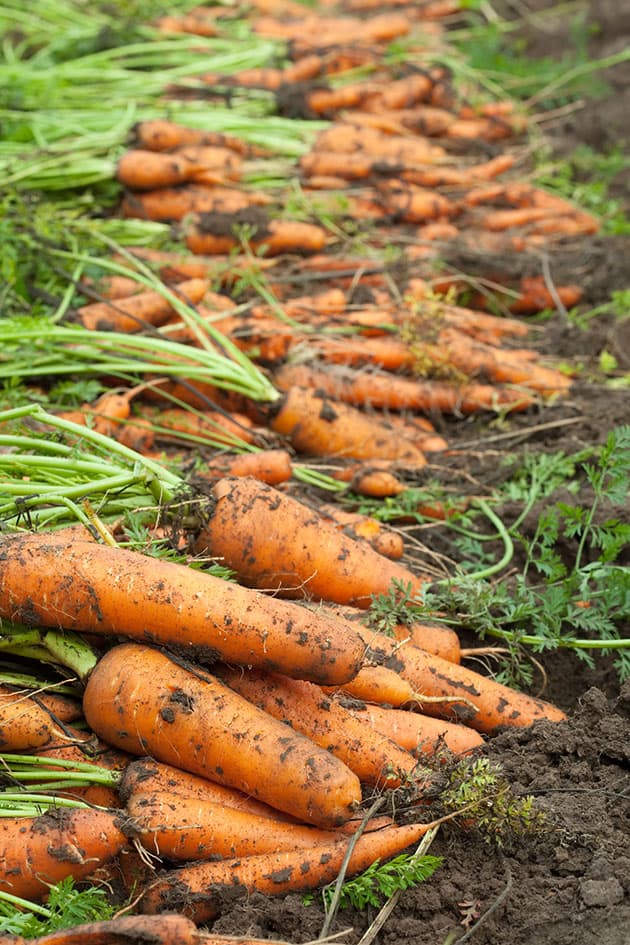
Carrots need 1 1/2 square inch around them to grow to full size. Seeds need to be planted 1/4” – 1/2” deep. It takes carrot seeds around 8-15 days to germinate. During this time the soil should be kept moist. To help with germination, cover the ground with a frost fabric or a plastic (clear or black, it doesn’t matter) after you plant the seeds and until the seeds germinate.
Another thing to remember is that carrot seeds are always direct-seeded, we never start carrot seeds indoors (however, you can plant carrots in containers if you like).
Carrot seeds are tiny and it can be challenging to plant and space them correctly. If you find it hard to handle the tiny seeds you can order pelleted carrot seeds…
Pelleted seeds – these are seeds that are coated with a white coating. The coating makes them a little bigger (like tiny balls) and also helps to keep moisture around the seed as it germinates. Pelleted seeds can be planted by hand and since they are white and larger they make it easier for the gardener to space the seeds correctly (which means less time thinning and less seed waste).
Pelleted seeds also make it possible to use a seeder so if you are planting a large area and want to use a mechanical seeder, you’ll want to purchase pelleted seeds. You can learn more about pelleted seeds in this short video.
Planting non-pelleted carrot seeds – if you are planting non-pelleted carrot seeds you are most likely not going to be able to space them correctly. Go ahead and sprinkle the seeds in the planting furrow. Cover them and let them germinate and grow a little bit. Once the seedlings are a few inches tall, you are going to have to thin them.
How to Thin Carrots…
If you weren’t able to space your seeds correctly at planting time, you’ll have to thin your carrots as they grow so they each have about 1 – 1 1/2 inches around them. I have a full post on how to thin carrots and I also have a video that shows you how I do this. I thin carrots in two stages…
Stage one – is thinning when the carrot seedlings are about 4” tall. I use tomato clippers and cut the seedlings at the soil level. This is better than pulling because the tiny roots might be tangled under the soil. When you pull one seedling you can damage the roots of the one that you want to leave. So cutting at the soil level at this stage is better. I thin the carrot seedlings to 1/2 inch apart and use the seedlings that I thinned in my salads (they are delicious!).
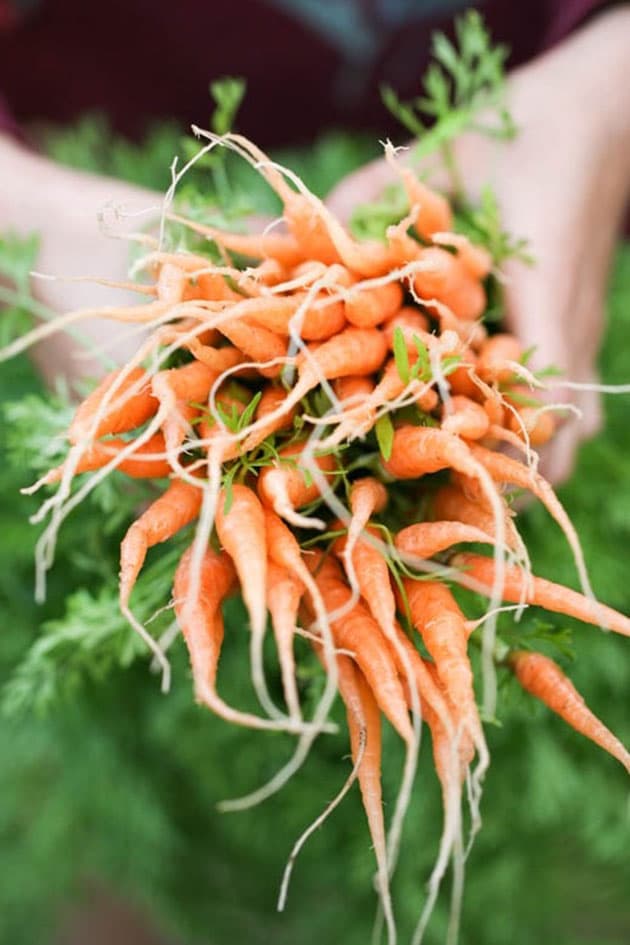
Stage two – I let the carrots grow for a few more weeks before I thin again. At this point, they have developed roots but the carrots are small (like in the photo above). In this second stage, I actually get a harvest of baby carrots. They are fun to eat, delicious, and sell really well in the farmer’s market. After thinning again, I now have a bed of carrots with 1 – 1 1/2 inches between the plants. I’ll let these carrots grow to full size.
How to Care For Carrot Plants…
Weeding – weeding is so very important in the carrot bed but it’s pretty much done only when the carrot plants are small. As the tops grow, the tops shade the ground and there are almost no weeds to pull.
Watering – it is especially important to keep the soil moist after planting and when the seedlings are young. Later, as the carrots grow, just like most other garden vegetables, they need about an inch of water a week.
Pests – I personally never have pests problems when it comes to carrots. And let me tell you… We have all the pests here in the South. Carrots are not too attractive to pests, however, there are a couple that can bother them; the carrot rust fly and the carrot weevil. These guys cause brown spots and feed on the carrot root.
In the organic home garden, you can try to spray your carrots with neem oil. You can also try to cover your crop with anti-insect netting around August which is when the rust fly lays its eggs. I think that one of the reasons that I have never had to deal with these guys is that I don’t have carrots in my garden in August.
Fertilizing – as I said before, carrots are not heavy feeders and there is really no need to feed them as they grow.
How to Harvest Carrots…
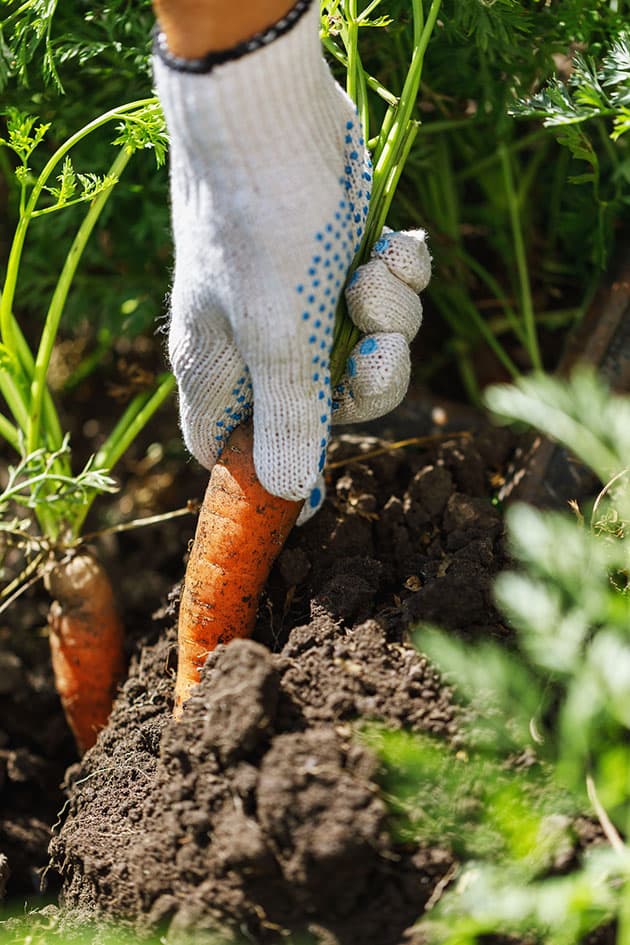
Most varieties of carrot take somewhere between 60-80 days to reach maturity (full-size carrots). You should know that carrots develop taste and color at the same time so really, you can pick carrots at any stage. If you want to pick them young, go for it. If you want to pick them at full size, that works too.
Just consider that you don’t want to leave them in the ground for too long or when it gets too hot. If you do, they might split or become woody and too hard.
However, in some gardening zones, you can leave carrots in the ground during the winter. In this case, you can plant the seeds in the fall, by the first frost the carrots will reach full size.
At this point, you can cover your bed with frost fabric or greenhouse plastic to protect the tops from the frost (see how I do it in this video). The soil cools down and acts as a fridge. Then during the winter, you can still go out to the garden and harvest carrots.
This might not be an option for you if you live up North though. It works great here in the South but up North, the soil might get too cold during the winter. If it does, make sure that you harvest your carrots before the first frost.
How to Store Fresh Garden Carrots…
Carrots are one of the best storage crops! They store very well in cold storage and can last for months.
Cold room or root cellar – if you have a cold room or a root cellar, pack your fresh carrots into bins in layers covered by potting soil. Water the bin to make the soil damp and store it away. Any time that you need a carrot reach into the bin and pull one. Cover the remaining carrots back with the potting soil.
Fridge or freezer – of course, you can also store carrots in the fridge if you don’t have too many. And carrots freeze well too. Here is how to freeze carrots (here is a video too) and how to freeze shredded carrots in case you want bags of them ready in the freezer for a carrot cake!
Canning and dehydrating – lastly, carrots can also be dehydrated and they can also be canned (here is how to can carrots) if you don’t have a cold room and want them to last on the shelf for months.
How to Use Carrot Tops…

Before we are done here, I wanted to make sure that I leave you with a piece of information that most people overlook when it comes to carrots… Carrot tops are edible too!
As I mentioned before, I add the little seedlings that I thin to my salad. They are so healthy and flavorful. With the older tops, I make carrot top pesto just as I make basil pesto. It’s delicious! It also freezes very well so if you want to preserve the tops, you can make a whole lot of pesto and freeze it.
Carrots are such a rewarding crop to grow! The few things that you should remember when it comes to growing carrots is to loosen the soil, not too much nitrogen rich fertilizer, and thin them right! Keep the bed clean of weeds and water well and you’ll have an amazing source of food right from the garden.
I hope that this post was helpful! If there are any carrot growing problems that you have come across and I didn’t cover, please let me know in the comments below.
If you liked this gardening post, make sure to check these as well…
The Complete Guide to Growing Potatoes

Hi! I’m Lady Lee. I help homesteaders simplify their homesteading journey while still producing a ton of food! I am a single mother of four, I was born in Israel and raised in an agricultural commune called a Kibbutz. Now I homestead in central NC.

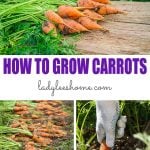
Plant carrot seeds when the soil hits 40°F (4.4°C) and germinate them at 55-65°F (12.8-18.3°C), avoiding temperatures above 75°F (23.9°C).
Carrots are tricky! But it seems like you know what you are doing. I’m just about to plant my fall carrots.